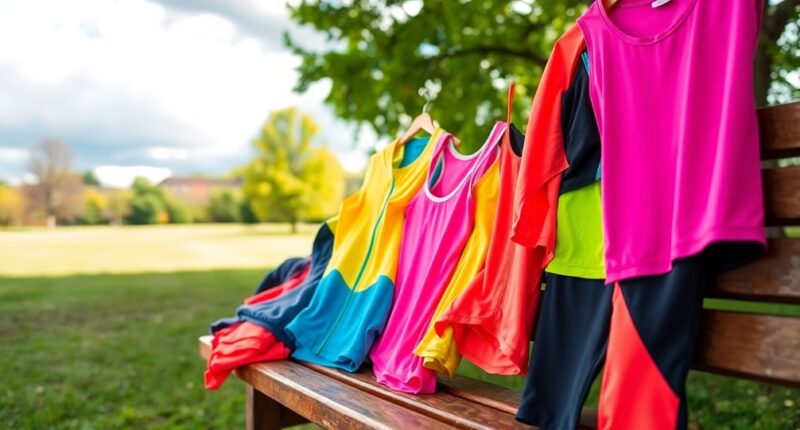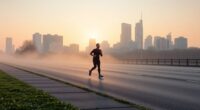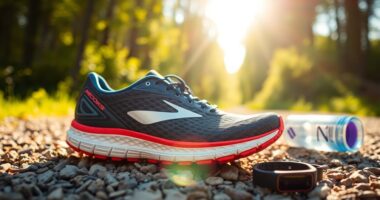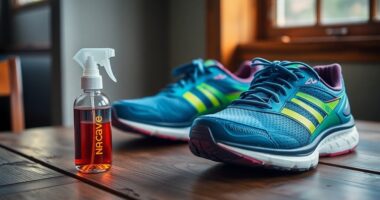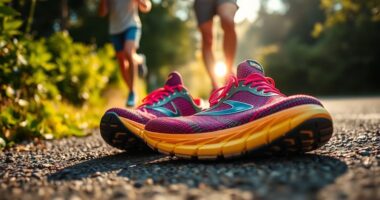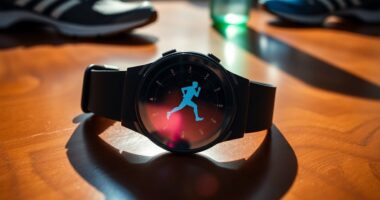Choosing the right running apparel for any weather is essential for comfort and performance. In cold conditions, wear moisture-wicking base layers and insulating outer layers. For milder weather, opt for breathable fabrics like shorts and long-sleeve shirts. In warm climates, select lightweight, moisture-wicking clothing. Don’t forget the right footwear for support and moisture-wicking socks to prevent blisters. Consider accessories like hats and hydration packs. Keep going to discover more tips on optimizing your running gear. Additionally, it’s important to explore sustainable running apparel options that not only support your performance but also benefit the environment. Look for brands that prioritize eco-friendly materials and practices in their production processes. By choosing sustainable gear, you can run with a clear conscience while still enjoying the comfort and functionality essential for your workouts.
Key Takeaways
- Select moisture-wicking base layers for effective sweat management, adjusting thickness based on temperature and activity intensity.
- Layer with insulating mid-layers for added warmth in cooler weather, choosing materials that trap heat without bulk.
- Opt for weather-resistant outer layers to protect against wind, rain, and snow, ensuring breathability for comfort during runs.
- Choose appropriate footwear that fits well, with moisture-wicking socks to enhance comfort and prevent blisters during runs.
- Incorporate accessories like hats, gloves, and reflective gear to enhance safety, comfort, and protection during various weather conditions.
Understanding Weather Conditions for Running
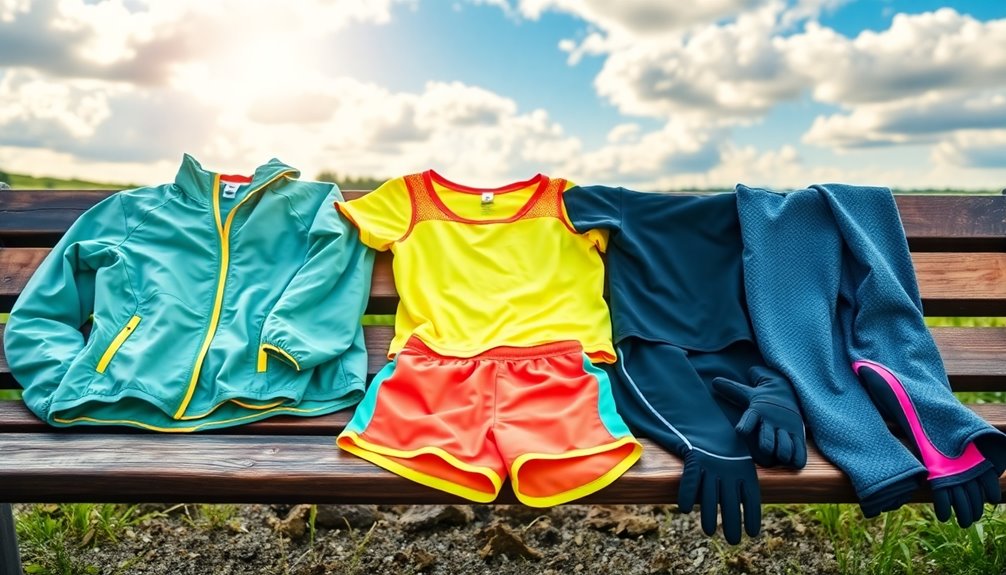
When you're gearing up for a run, understanding the weather conditions is essential to choosing the right apparel.
In cold weather, you need moisture-wicking base layers, insulating mid-layers, and wind-resistant outer layers to keep your body heat and prevent injury.
For mild temperatures, breathable fabrics help with temperature regulation, allowing you to adapt as activity levels change.
When it's warm, lightweight, moisture-wicking clothing is a must, promoting airflow and protecting you from sun exposure with accessories like hats and sunglasses.
Remember, proper footwear and moisture-wicking socks are key in all conditions, preventing blisters and providing support. Additionally, understanding toilet maintenance can ensure a hygienic experience post-run, especially when using public restrooms.
Essential Base Layers for Every Temperature
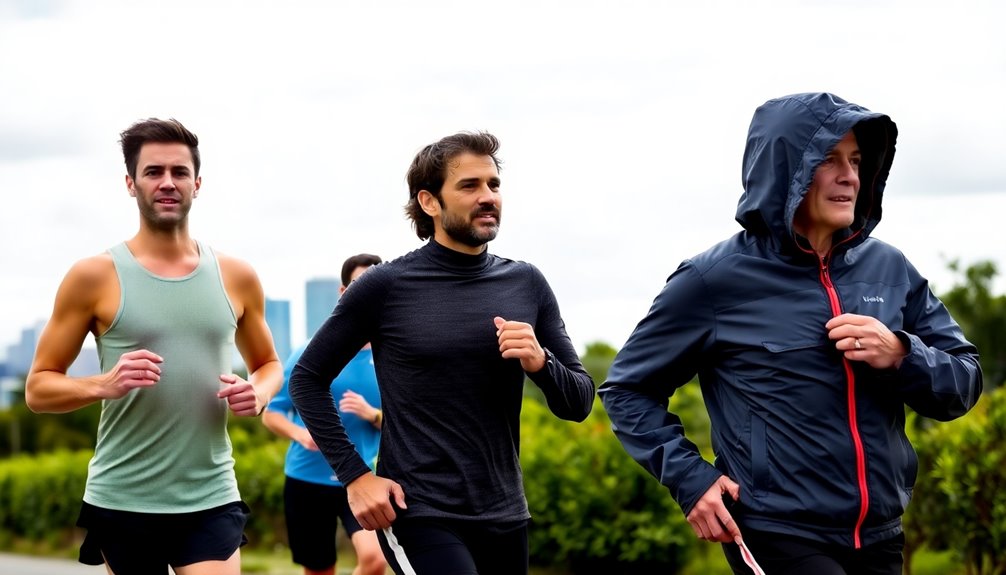
Choosing the right base layers is essential for maintaining comfort during your runs, regardless of the temperature.
In warm weather (10 to 15°C / 50 to 60°F), lightweight shorts and tank tops work well as base layers.
As the temperature drops (4 to 10°C / 40 to 50°F), switch to shorts with a long sleeve shirt to keep you warm.
For cooler conditions (0 to 4°C / 30 to 40°F), a long sleeve shirt with running tights provides moisture-wicking insulation.
In colder climates (0 to -1°C / 20 to 30°F), opt for a thermal long sleeve under full-length tights for maximum heat retention.
For extreme cold (below -6°C / 20°F), invest in thermal base layers and wind-resistant options to stay protected. Color accuracy in your running gear can also enhance your overall comfort and performance during various weather conditions.
Choosing the Right Outer Layers for Protection
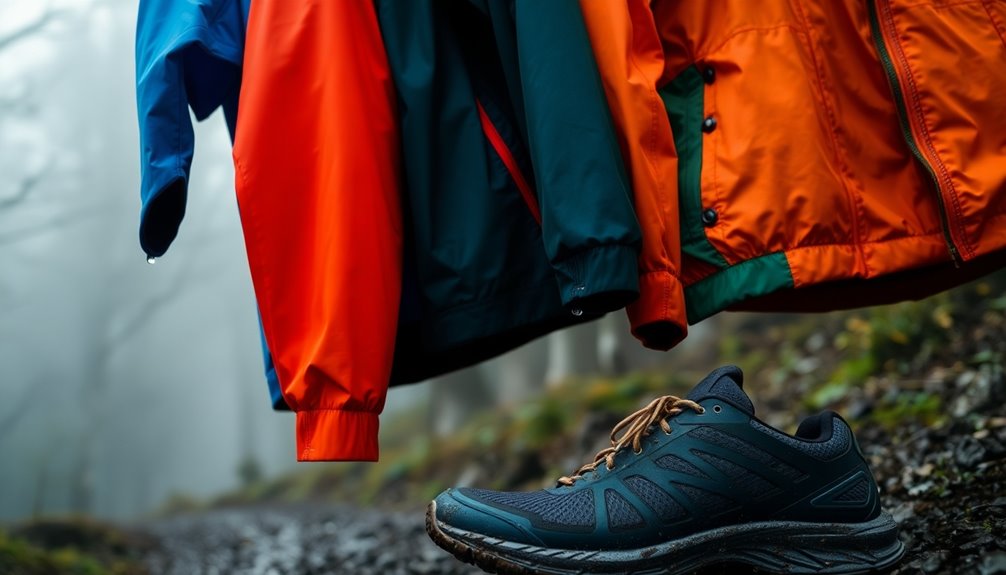
The right outer layers can make all the difference in your running experience, offering essential protection from the elements.
When selecting running jackets, opt for lightweight, weatherproof options that shield against wind, rain, and snow while ensuring moisture escape to keep your body temperature stable.
Breathable materials are vital, as they help regulate your core temperature and prevent overheating during intense runs.
For mild to cool weather, a packable windbreaker provides versatile protection without bulk.
In colder conditions, insulated running jackets trap heat while allowing for movement.
For extreme cold, consider wind-resistant jackets layered over thermal base layers for ideal warmth and protection.
Additionally, investing in a best home security system can ensure your belongings are safe while you focus on your runs.
Choose wisely, and your runs will be more enjoyable, regardless of the weather.
Footwear: Finding Comfort and Support

When it comes to running, finding the right footwear is essential for your comfort and support. You need to take into account the fit, cushioning, and whether you require stability or motion-control features. The right shoes not only enhance your performance but also help prevent injuries, so let's explore how to choose wisely. Additionally, investing in quality footwear can be seen as a form of long-term strategy to support your overall health and fitness goals.
Shoe Fit and Size
Finding the right fit in running shoes can make all the difference in your comfort and performance. To guarantee you achieve a proper fit, consider these key points:
- Space: Leave about a thumb's width between your longest toe and the shoe's toe box to accommodate foot swelling during runs.
- Timing: Try on shoes at the end of the day when your feet are most swollen to get an accurate fit.
- Gait Analysis: Get a professional gait analysis to determine your arch type and select the right stability or neutral running shoes.
- Socks: Opt for moisture-wicking socks to enhance shoe fit and reduce friction, minimizing the risk of blisters.
- Additionally, advanced filtration systems in your running environment can help reduce allergens that may affect your performance.
Cushioning and Support
Cushioning and support are essential elements in running shoes that can greatly enhance your comfort and performance. When choosing shoes, consider factors like size, width, and the level of cushioning that best fits your running style.
Proper cushioning absorbs shock, protecting your joints and reducing fatigue, especially during longer runs. Look for shoes that offer moisture-wicking properties to keep your feet dry, no matter the temperature. Additionally, consider footwear that provides proper cushioning to further minimize impact on your joints while running.
Stability and Motion Control
While selecting the right footwear, it's crucial to take into account stability and motion control features that cater to your unique running style.
If you experience overpronation, consider these options:
- Stability shoes: These provide added support to help maintain proper alignment and reduce injury risk.
- Motion control shoes: Ideal for severe overpronators, they offer maximum support and prevent excessive inward rolling.
- Professional gait analysis: This can pinpoint your specific foot mechanics, ensuring you choose the best footwear for comfort and performance.
- Regular shoe replacement: Replace your running shoes every 300 to 500 miles to maintain cushioning and support.
Choosing the right shoes helps you run safely and efficiently, enhancing your overall experience. Additionally, understanding the importance of diversification in your fitness routine can further enhance your performance and reduce the risk of injury.
Selecting the Best Accessories for Running

When you hit the pavement, the right accessories can make all the difference in your experience.
From weather-specific items like hats and gloves to essential safety gear such as reflective vests, these accessories enhance both comfort and security during your runs. Additionally, incorporating energy-saving features into your running gear, such as moisture-wicking fabrics, can help improve your overall performance and comfort in varying conditions.
Let's explore how to choose the best pieces to elevate your running routine.
Essential Weather Accessories
Choosing the right weather accessories can make a significant difference in your running experience, especially as conditions change. Here are four essential items to take into account:
- Hats: Lightweight running hats protect against sun and retain warmth in colder weather.
- Gloves: Moisture-wicking gloves keep your hands warm while guaranteeing breathability and touch-screen compatibility.
- Sunglasses: UV-protective sunglasses shield your eyes from harmful rays and reduce glare, enhancing visibility.
- Hydration Packs: These are vital for long runs, allowing you to carry water and essentials conveniently.
Additionally, don't forget to wear reflective gear when running in low-light conditions for improved safety. It's also important to consider parental involvement in your running routine, as it can help foster a healthy lifestyle for your family.
Equip yourself with these accessories to guarantee a comfortable and safe running experience in any weather.
Comfort and Safety Gear
Selecting the right comfort and safety gear is vital for enhancing your running experience and guaranteeing your well-being during workouts.
Start with moisture-wicking clothing to keep sweat at bay and maintain comfort. A running watch can help you track your pace and distance, while hydration packs or belts make sure you stay hydrated without sacrificing mobility.
Don't forget light gloves for colder weather; they provide insulation and maintain dexterity. For sun protection, a secure-fitting hat and UV-blocking sunglasses are essential to protect your eyes from harmful rays.
Finally, invest in reflective gear to enhance visibility during early morning or late evening runs, incorporating important safety features that keep you visible to others. Additionally, maintaining high vibrational energy during your runs can improve your overall performance and enjoyment.
Layering Techniques for Temperature Adaptation
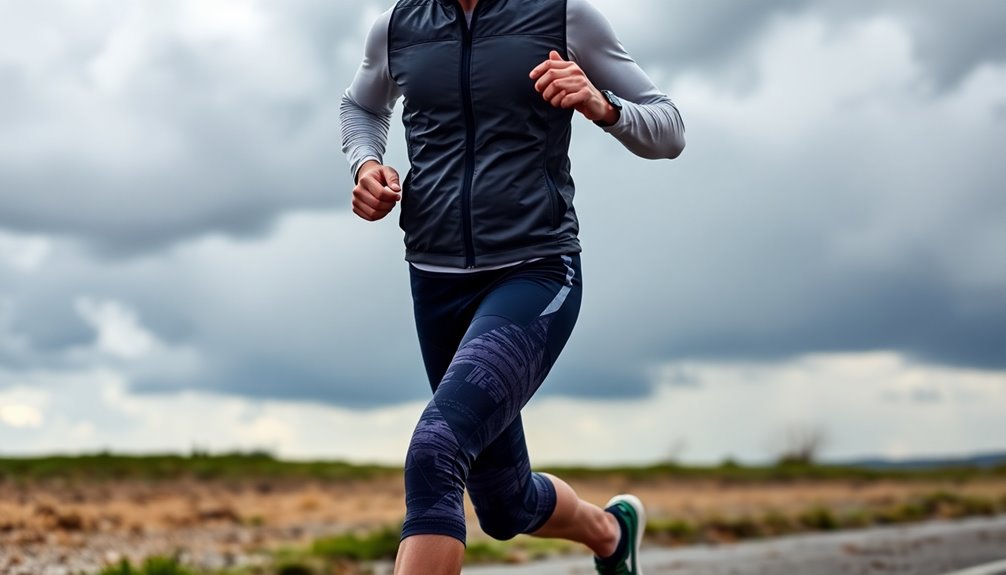
To effectively adapt to varying temperatures during your runs, mastering layering techniques is key. Proper layering helps regulate your body temperature and keeps you comfortable.
Here's how to layer effectively:
- Base Layer: Start with a moisture-wicking base layer that pulls sweat away from your skin, keeping you dry.
- Insulating Layer: Add insulating layers, like fleeces or thermal tops, to trap heat without adding bulk.
- Outer Layer: Use outer layers, such as windbreakers or waterproof jackets, to shield against wind, rain, and snow while allowing moisture to escape.
- Adjust Layers: Be ready to adjust your layers based on your running intensity; as your body temperature rises, shed outer layers to prevent overheating.
With these techniques, you can stay comfortable no matter the weather.
Importance of Moisture-Wicking Fabrics
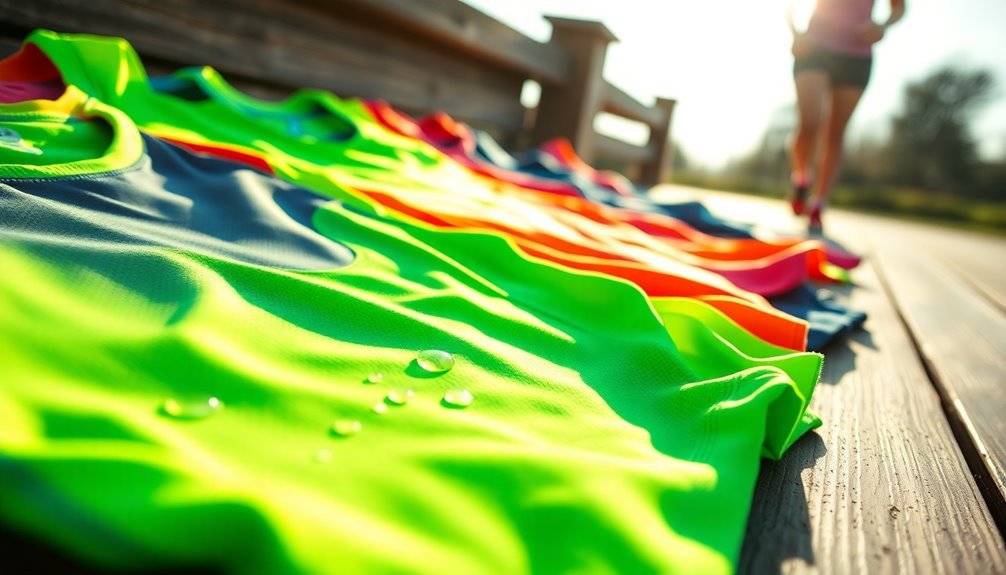
When you're out running, comfort is key, and moisture-wicking fabrics play an essential role in achieving that.
These materials pull sweat away from your skin, helping to regulate your body temperature and keep you feeling fresh.
Enhanced Comfort During Runs
While you're out on a run, the last thing you want is to feel weighed down by sweat-soaked clothing.
That's where moisture-wicking fabrics come into play. These materials are designed to keep you dry and comfortable, making your running routine much more enjoyable.
Here's why you should choose moisture-wicking apparel:
- Quick Drying: They dry rapidly, minimizing chafing and discomfort.
- Breathability: Enhanced ventilation helps regulate temperature during your run.
- Antimicrobial Properties: Many fabrics resist odors, keeping you feeling fresh.
- Optimal Performance: Staying dry and cool reduces fatigue, letting you run longer.
Incorporating a moisture-wicking base layer into your gear guarantees you focus on your run, not your discomfort.
Temperature Regulation Benefits
Moisture-wicking fabrics play a significant role in temperature regulation, ensuring you stay comfortable no matter the weather conditions. These materials, like polyester and merino wool, pull sweat away from your skin, promoting rapid evaporation and reducing the risk of overheating. They provide good insulation while allowing for breathability, which is essential for runners.
| Fabric Type | Key Benefits |
|---|---|
| Polyester | Quick drying, lightweight |
| Nylon | Durable, strong moisture-wicking |
| Merino Wool | Good insulation, temperature control |
| Bamboo | Antimicrobial, soft feel |
| Spandex | Stretchy, allows movement |
Enhancing Visibility With Reflective Gear
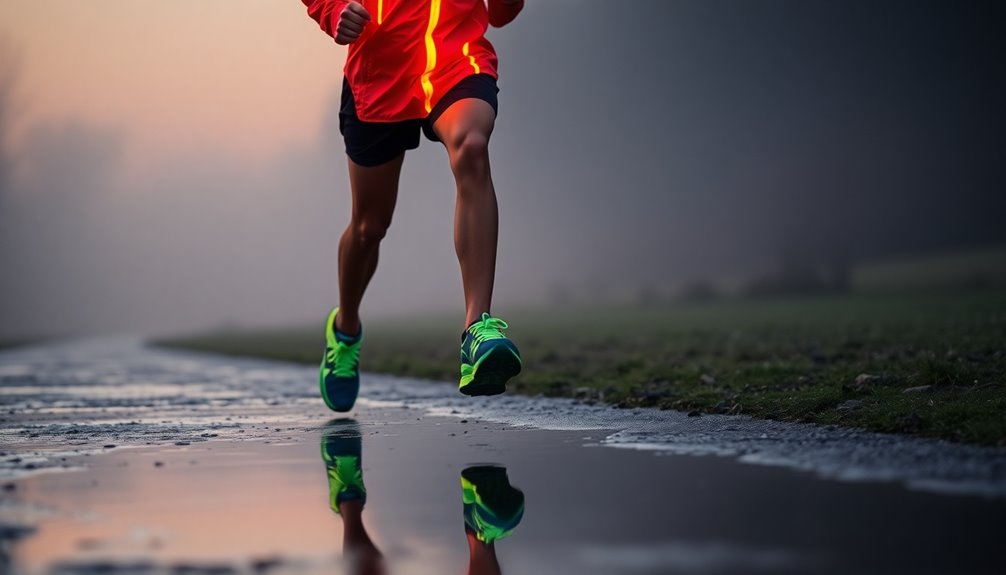
How can you stay safe during those early morning or evening runs? One of the best ways is by using reflective gear to enhance your visibility. This gear considerably reduces the risk of accidents, making you more noticeable to drivers.
Here are four essential items to evaluate:
- Reflective vests – These increase your visibility from a distance of up to 1,000 feet.
- Reflective armbands – Lightweight and breathable, they can be worn comfortably during your run.
- Ankle straps – These are great for reflecting light as you move.
- Clothing with reflective elements – Stripes or logos can enhance safety without compromising style.
Utilizing Wearable Technology for Performance Tracking
As you endeavor to improve your running performance, utilizing wearable technology can provide you with essential insights into your training.
Running watches, like the Garmin Forerunner 245, offer performance tracking by monitoring metrics such as distance, pace, heart rate, and calories burned. These devices often include GPS functionality, ensuring accurate route tracking, even in remote areas.
Additionally, advanced models feature health monitoring capabilities, tracking hydration levels and recovery times, crucial for preventing injuries. Safety features like incident detection and emergency contact notifications further enhance your security during outdoor runs.
Seasonal Adjustments to Your Running Wardrobe
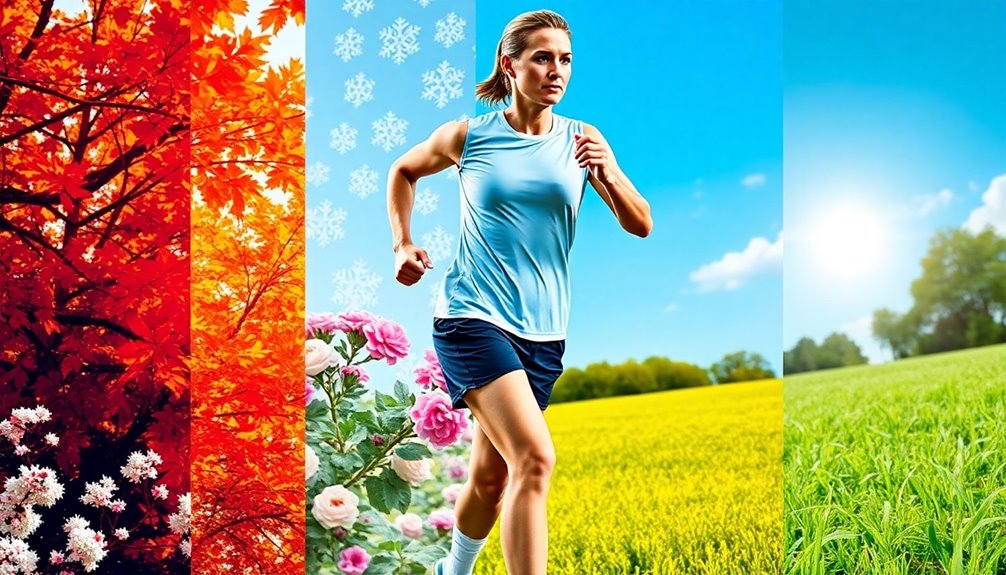
When the seasons change, your running wardrobe should adapt to keep you comfortable and safe on your runs.
Here's how to adjust your gear for different temperatures:
- Winter (40°F and below): Layer a moisture-wicking base layer, an insulating mid-layer, and a windproof outer layer.
- Spring/Fall (40-60°F): Use a long-sleeve shirt with a short-sleeve over it, and consider running tights paired with shorts for breathability and warmth.
- Summer (60°F and higher): Choose lightweight, moisture-wicking fabrics like running shorts and loose tops to enhance airflow and provide sun protection.
- Cool Temperatures (30-40°F): Wear long-sleeve shirts with insulating layers, adding gloves and hats to maintain warmth.
Always prioritize breathable fabrics to guarantee comfort during your runs.
Frequently Asked Questions
What Should I Wear Running Based on Weather?
When you're deciding what to wear for running based on the weather, consider the temperature first.
In warm weather, go for moisture-wicking shorts and a tank top.
For mild days, pair shorts with a long-sleeve shirt and a windbreaker.
In cooler conditions, wear long sleeves with crops or tights.
For cold weather, opt for long sleeves and full-length tights, adding a jacket.
In extreme cold, layer thermal and wind-resistant gear to stay warm.
How Many Layers for 0 Degree Weather?
When it's 0 degrees Celsius, you'll feel like you're running through the Arctic!
You need at least three layers to stay warm. Start with a moisture-wicking base layer made of polyester or merino wool.
Add an insulating mid-layer, like fleece, to trap heat.
Finally, finish with a wind-resistant outer layer to fend off chill.
Don't forget accessories like gloves and a thermal hat; they're essential for keeping your extremities cozy!
What Weather Conditions Are Best for Running?
The best weather conditions for running typically range from 40°F to 60°F (4°C to 15°C), where you can enjoy breathable layers that keep you comfortable.
If it's between 60°F and 70°F (15°C to 21°C), lightweight, moisture-wicking fabrics help prevent overheating.
Cold weather can work too, especially down to 30°F (-1°C), but you'll need insulated layers to stay warm.
Just avoid running in extreme heat above 90°F (32°C) for safety.
How to Choose Running Clothes?
When you're out there running, the last thing you want is discomfort.
So, how do you choose the right clothes? Start with moisture-wicking fabrics like polyester to keep sweat away.
Layer wisely with breathable base layers and insulating options, topped off with a protective outer layer.
Don't forget about shoes that fit your foot type perfectly.
And accessories like hats and gloves can make a world of difference.
Your run's comfort depends on it!
Conclusion
As you lace up your shoes and step outside, you can feel the crisp air wrap around you like a comforting embrace. With the right gear, you're ready to conquer whatever the weather throws your way—be it the sun's warm rays or a sudden chill. By choosing the perfect layers, accessories, and footwear, you're not just preparing for a run; you're setting the stage for an unforgettable experience, where every stride feels just right.
